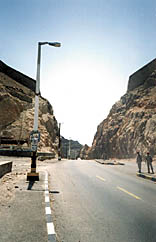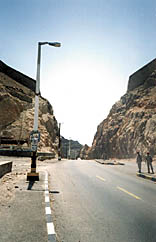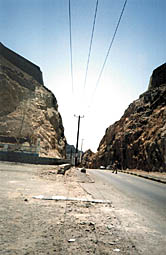
Aden’s Historical Wall & Gates [Archives:1998/38/Last Page]
September 21 1998
The building of the Aden wall has accompanied the increasing importance of the city’s commercial and political role. It was originally erected to regulate the flow of goods in and out of the city, on their way to and from its world famous port.

As can be expected, the Aden wall served as part of the city’s military defenses. A lot was written about this wall, but not many details were given. Old historians go as far back as the Islamic era. Abu Al-Fida in his Taqweem Al-Buldan (chronicle of the countries), dated the wall back to the time before the establishment of Bani Zorai’ dynasty. He indicated that, land-wise, Aden was well fortified by a range of mountains, on top of which was a series of castles and watch towers. While the wall, Abu Al-Fida explained, blocked Aden’s only passage – in between the mountains – to the seafront.
When the Sulayhids, led by Mohammed Al-Solaihi, occupied Yemen in 1059 AD, Aden was governed by Bani Zurai’, who declared their allegiance to the new rulers of Yemen. Most of the Aden fortifications were originally built by the Bani Zurai’ rulers.
Al-Zanjabily Adds Two More Walls
During the reign of Abu Othman Omar Al-Zanjabily of the Ayyubid (1176) dynasty, Aden became a very important trade center. Al-Zanjabily renovated Aden’s wall and gates. Moreover, he added another wall running in parallel to the original one from Al-Khadra fortress to Al-Taakir fortress. A third wall was erected in parallel, extending to the Haqqat mountain.
As far as gates were concerned, Abu Otham ordered the making of six gates in the Aden wall: Bab Al-Sibagha, Bab Howma, Bab Al-Saile (was an escape route for flash floods), Bab Al-Fardha (now Bab Adan), Bab Mushrif or Bab Al-Sahil, and Bab Haif or Bab Al-Sirr (used to be opened only for important matters relating to state security).
During the prosperous Rasulyd reign (1233-1455 AD), the Aden walls and fortresses were restored and renovated. Many schools and mosques were also built at that time.

Bab Adan (Aden gate) was the most famous of the city’s gateways, which is considered an architectural marvel. Cut into mountain rock, Bab Adan was described by historians as the most unique of its kind in the whole of Yemen. It was also called Bab Al-Barr (land gate) and Bab Al-Aqaba..
It was the only land gateway for Aden, so the British called the “Main Passageway.”
Much renovation work was done on Bab Adan throughout the ages and by different rulers and reigning dynasties due to its great importance.
Changes by Colonialists
A lot of changes were added to the Aden gate during the British occupation. The actual gate was removed, and a new watch tower was built to replace a rundown one. Two cannons were placed on the Hadeed Mountain overlooking the Ahwash road. The bridge over the narrow passage was renovated, and a serpentine road was cut into Al-Taakir mountain.
In the early Sixties, however, the British forces demolished the bridge altogether when they widened the road going through the Aden gate.
A visitor to Aden toady can see the remnants of the Aden walls and some of the fortresses on the peaks of the Hadeed, Al-Akhdar, and Haqqat mountains.
By Ridhwan Al-Saqqaf,
Yemen Times, Aden
——
[archive-e:38-v:1998-y:1998-d:1998-09-21-p:./1998/iss38/lastpage.htm]


